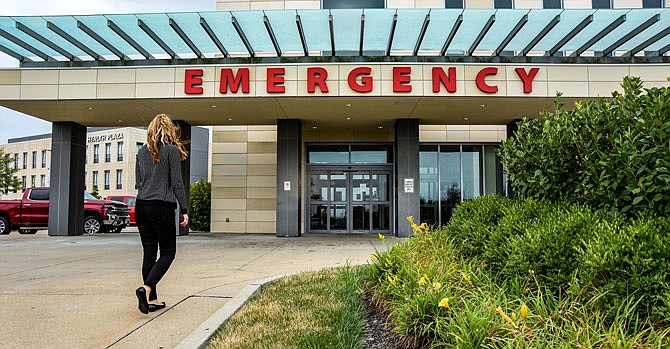Missouri Gov. Mike Parson said Wednesday that SSM Health in Jefferson City will be among the hospitals and hospital systems to receive out-of-state staffing aid through a contract with a Texas-based company.
Parson earlier this month named 12 hospitals and hospital systems across the state, including St. Louis- based SSM Health, set to receive up to 760 out-of-state health care workers to address staffing needs during the COVID-19 pandemic - part of an agreement with Vizient Inc.
Parson on Wednesday named six hospitals and hospital systems that will receive 117 contracted health care workers from out-of-state through the agreement over the coming weeks, starting Monday.
Those six health care institutions are SSM Health in St. Louis and Jefferson City (which would be St. Mary's Hospital), St. Luke's Hospital in Chesterfield, MOSAIC Life Center (St. Joseph), Hannibal Regional Healthcare System, BJC HealthCare (St. Louis) and Cox Health (Springfield).
A spokeswoman for SSM Health St. Mary's Hospital in Jefferson City did not immediately respond Wednesday to request for further comment.
Parson's office outlined that of the 117 contracted staff coming: 20 would be intensive care unit registered nurses; 18 would be medical-surgical registered nurses; 13 would be telemetry RNs; 50 would be respiratory therapists; and 16 would be certified nurse's aides or patient care technicians.
Parson said 42 more contracted staff would be coming later. A news release from his office stated those "offers are pending with staffing agencies and contract employees."
There was no update Wednesday on what the agreement with Vizient will cost, though the state is using federal Coronavirus Aid, Relief and Economic Security Act funding to pay for the agreement through the end of the year, with hospitals picking up the tab after that - the whole agreement lasting at least 12 weeks.
Vaccine distribution
Meanwhile, health care workers continue to receive Pfizer Inc. and German partner BioNTech's COVID-19 vaccine - of which the first 51,675 doses for Missouri arrived this week.
Parson's office said nearly 1,000 front line health care workers had already received their shots - the first of two for the two-dose vaccine, the second of which will have to be given at least 21 days later.
The governor's office stated the number of health care workers to get their first shots "will exponentially increase over the coming days and weeks as more vaccine shipments arrive."
The state expects to receive more of the Pfizer vaccine next week, as well as perhaps a first shipment of 105,300 Moderna Inc. vaccine doses, pending approval by federal regulators.
Moderna's vaccine is also two-dose - the second dose having to come at least 28 days after the first - and, like Pfizer's, is 95 percent effective.
For now, with limited supplies of the vaccine, the state is focusing on protecting health care workers and long-term care facility residents and staff - approximately 478,000 people, in total.
After that Phase 1A in the state's vaccine distribution plan, there would still be more than 2.6 million people who are older than 65, have underlying health conditions, are first responders, or who are essential employees in critical services such as child care, education and utilities who would be prioritized in Phase 1B to receive a COVID-19 vaccine over the general public - not counting groups of people in Phase 2 who would also be prioritized over the general public, which is Phase 3.
Officials' estimates for when the general public might expect to be able to get a vaccine will likely continue to change based on when and how many different vaccines are available, and how many of each is on hand.
State health director Dr. Randall Williams said Wednesday he hoped Phase 3 for the general public would come in mid-April.
Williams also said it's possible vaccines from AstraZeneca and Johnson & Johnson might become available in February.
He said Pfizer's vaccine - the only one to get approval so far - is safe and effective, and less than 10 percent of people who receive it experience mild side effects, which are more likely after the second dose.
Williams said those side effects go away after a day or two, and include fatigue in about 4 percent of people, headaches in 2 percent, muscle pain in 1 percent and chills in 1 percent.
He pointed people with questions about the vaccine and the process of approving and distributing it to visit MOStopsCovid.com (also available at covidvaccine.mo.gov).
To achieve herd immunity in Missouri - where enough people are immune to the coronavirus that causes COVID-19 that sustained community transmission would no longer be possible - Williams said 75 percent of people would either have to have gotten a vaccine, or gotten COVID-19, recovered and developed immunity.
He said approximately 10 percent of Missourians have been exposed to COVID-19.
Parson credited Missourians with taking it upon themselves to abide by personal precautions - including social distancing, wearing a mask, washing one's hands, avoiding crowds and avoiding being with someone outside one's household for a total of 15 minutes or more - for avoiding a post-Thanksgiving holiday surge.
Parson said Missourians need to take those same precautions over the coming Christmas and other holidays.
"These actions are making a difference," he said.

